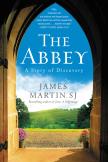Dealing with Grief
James Martin, S.J., is the author or editor of over a dozen books on the Jesuits and a variety of other topics. Commended by a fellow Catholic novelist, Ron Hansen, and the well-known memoirist Kathleen Norris, The Abbey is his first work of fiction.
The novel begins in a Philadelphia suburb in late spring. Mark Matthews, in whose perspective the novel begins, is a laid-off 30-something architect. He moved from Boston to take a full-time handyman’s job at the Trappist Abbey of Saints Philip and John.
Mark rents a house from Anne, a 40-year-old single mother whose son Jeremiah died in a car-bike accident when he was 13. That was three years ago, and she is still grieving. Anne is the child of a Catholic couple, both deceased. Her father, an accountant, had done the abbey’s books, but Anne “wasn’t a believer” and, except for an anomalous fact or two, seems to know little about Catholicism.
When Anne’s car breaks down, Mark takes her to the abbey while he retrieves his cell phone. Momentarily left alone in a hallway, Anne smells incense and hears the monks chanting compline, ending with a “hymn”—the “Salve Regina”—that she remembers her father humming. She breaks down thinking of Jeremiah.
After compline, a tall, thin monk with Buddy Holly glasses and Birkenstocks comforts her. Leaving the abbey, Anne sees an icon of the Mother and Child. The monk, who is Father Paul the abbot, gives her a picture of the icon. Later, Anne discovers the “Stabat Mater” on the reverse.
Returning to the abbey, she meets Father Edward, the priest her father had asked to baptize her. Some days later, Anne ends up speaking to the abbot again. Over the course of several conversations she comes to acknowledge her grief, realizes the narrowness of her images of God and tries to pray. Father Paul’s counsels come right out of the Spiritual Exercises of St. Ignatius. Read in the spirit of the novel’s best parts, those counsels and Anne’s responses are genuinely moving.
Late in the novel we learn of Anne’s love for gardening and its special link to her past. Wearing her mother’s hat and her father’s gloves, she plants flowers, “gently tamping down the soil” around them. “Then she had a strange feeling—almost as if God was patting down the soil around her life. She felt comforted. Calm.”
Mark’s character grows more slowly in complexity. To Anne he is just her tenant and a “frat boy,” and she rebuffs his offers of a closer friendship, leaving the reader to wonder what might become of the relationship. Only when Mark begins to talk with the abbot about his vocation as a carpenter does his character become more genuine.
The last chapter begins as the monks enter the chapel for compline. The narrator identifies a priest with thick glasses, an old priest with a walker and a handful of lay participants at the back of the chapel. They include a woman of 40 and the monastery carpenter. Anne does not see Mark, and Mark is too far back to recognize Anne. Both, however, join in singing the “Salve Regina.”
In his Acknowledgments, Father Martin says the novel is “based on a dream.” The subtitle, “A Story of Discovery,” is accurate. Anne does discover the healing power of prayer, memory and the experience of sharing the story of her grief. The icon, the “Stabat Mater, the “Salve Regina” and Anne’s gardening are all threads from which the author weaves a cloak of healing that finally enwraps Anne.
For whom is this novel written? One answer comes when Anne says she isn’t sure God exists, and if he does, she’s not sure she wants to know him. That, the age of the chief characters and some age-specific language suggest the novel will appeal to those Gen-Xers who are hesitant to express belief and who keep religion at arm’s length.
The author handles his characters, even the minor ones, with gentleness and care: Father Edward, even Maddy, the “guest mistress” for the abbey’s retreat center. Jeremiah’s friend, Brad, for instance, becomes more real when, late in the novel, Anne embraces him, shares tears for Jeremiah with him and gives him Jeremiah’s baseball glove.
A genuine religious motive drives the plot of The Abbey, but the author has his hands full conveying the agony of Anne’s grief, Mark’s search for his vocation and the the abbot’s experience of his vocation. The style is sometimes closer to popular fiction than what one might find in something by Ron Hansen or Tobias Wolff, though both are much more experienced fiction writers than Father Martin.
There is nothing particularly Trappist about the abbey of Sts. Philip and John, unless the blueberry jam they make and the horarium that one character describes, are meant to suggest the order’s charism. Even with post-Vatican II reforms, the atmosphere of the abbey seems more generically Benedictine.
Father Paul’s musings about love, marriage and sex enlarge and complicate his character, but they distract from Anne’s experience of loss. Still, her progress in acknowledging her feelings and starting to talk to God about her love for Jeremiah brings moments of deep feeling.
The Abbey is, finally, a competent first novel, whose greatest strength is the seriousness and sensitivity with which it explores three deeply human themes.
This article also appeared in print, under the headline “Dealing with Grief,” in the October 19, 2015, issue.








